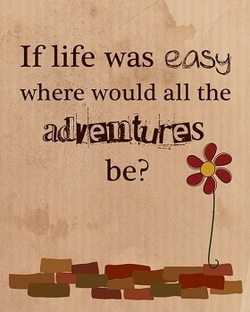 I am guilty of a most false assumption: “Everything in my life will go smoothly since I am on a spiritual journey.” Isn’t that cute? What a rude awakening to find out that I’m not always going to get my way from that God that I have always loved and tried to please! My first clue into this was the drive from Missouri to Florida right after being married. My new husband and I were enjoying the scenery, albeit a little lost. My husband pulled into a gas station to ask for directions (yeah, I got a winner) while I waited in the car. Out of nowhere, I was suddenly filled with jealous thoughts: “What if he finds someone in there more attractive than me? What if he finds her more interesting? What if? What if? What if?!” I was never jealous with previous boyfriends–not once. My attitude was, “Hey, if you want to date someone else, go right ahead. I don’t need to waste my time.” These thoughts that surfaced during our honeymoon trek came as a disarming and alien surprise. At the time, I didn’t know what to do with jealousy, and was quite embarrassed and overwhelmed by the emotions. I tried to hide what I was feeling, but didn’t do so well. Fortunately, my husband was kind enough to talk me through my feelings. …Which would have been great if all I needed to do was talk! I felt better in the moment, but those feelings were only a taste of what was to come. I had a whole slew of faulty childhood beliefs that were surfacing to be healed. This was what my spiritual journey was to be for several years: Clearing false beliefs from my childhood–not just jealousy, but a series of dysfunctional attitudes and concepts about relationships overall. What the heck? I wanted to be married and live happily ever after! I wanted to ride off into the sunset, live on the beach, and be eternally wise and wonderful! That emotional work was getting in my way of my FUN! How dare it! I eventually learned that this is the spiritual process, and healing needs showed up in all areas of life: my relationships, career endeavors, and how I perceived myself. Even those who wouldn’t consider themselves on the spiritual journey have issues that arise to be healed. This clearing of false beliefs, shedding light on what is real and true (until the next round of clearing!) is what this journey is about! It is simply part of our journey as humans moving into Something Greater. How disappointing, I have thought–at first and many times since then! Yet, how necessary to be able to move forward unimpeded by my fears and false assumptions. How much stronger my intuition became because of my willingness to do the work. What better life choices I have made because of my willingness to let go of my lesser ideas of “fun” and short-sighted ways of doing things. The spiritual journey is about clearing away our personal ideas of what is real, valid and important; and open to our intuitive nature that knows what is better for us. Our Higher Self waits for us to loose our little wills and cooperate with the bigger picture that can only be perceived when we tap into it! And we can’t tap into it while we hold fears and wrong ideas about whatever situation is at hand. The spiritual journey takes diligence, willingness, and spunk. What are you willing to let go of so you can grow? 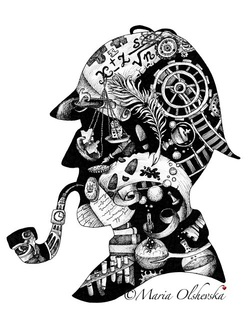 Change happens. Sometimes we change because we want to; sometimes we change because we have to. When dealing with a change that is out of our control, one of the best approaches is to Sherlock it. “My name is Sherlock Holmes. It is my business to know what other people don’t know.” Sherlock Holmes, The Adventure of the Blue Carbuncle You know Sherlock. He’s the odd, people-challenged character who sure knew how to solve mysteries. Don’t some changes feel like mysteries to you? Recently, my favorite yogurt brand changed the consistency, flavor and protein content of their product, and I wasn’t happy! I will use this silly example to walk you through the process of moving through a change that is out of your control so you can get a feel for the process. If it can work with yogurt, maybe it will transfer to any bigger change you may be dealing with! “…[W]hen a fact appears to be opposed to a long train of deductions it invariably proves to be capable of bearing some other interpretation.” Sherlock Holmes, A Study in Scarlet 1. What is the change that is happening around you? Describe the facts. What exactly is different? This company changed the protein content of my favorite yogurt went from 15 grams of protein down to 12! Plus, the consistency is more watery, and the flavor tastes watered down as well, but it’s cheaper! 2. Now you get to expand a little. How do you feel about this change? Are you angry, afraid, sad, or frustrated? Let it out, and include why you are feeling the way you do about this change. I feel really disappointed about this. I counted on those 15 grams of protein in the mornings when I didn’t have time for a larger breakfast. I would eat it at work as well, but now it isn’t satisfying as it was before. I don’t understand why they made these changes, and I feel angry. I feel especially frustrated because the only other comparable yogurt is at a grocery store that is inconveniently located! 3. What about this change is in your control? What about it is out of your control? (Keep to the facts here, too!) I can control whether or not I continue to purchase this brand of yogurt. I don’t have control over how it is made. I can write an email to the company, voicing my dissatisfaction, but I can’t control whether or not they do anything about my dissatisfaction, either. 4. What would be the best way for you to manage this change? What steps are you willing to take to make the necessary adjustments? I can consider other options, such as trying a different brand of yogurt, or making the trek to the other grocery store. I can also find other sources of quick proteins for my food intake needs, like protein bars. “Eliminate all other factors, and the one which remains must be the truth.” Sherlock Holmes, The Sign of Four Now it’s up to you what you decide to do. You can always choose to continue with emotional responses, such as disappointment, anger, frustration, sadness. If that’s the route you take, be sure to also answer this question: “For what good purpose would it serve for me to continue feeling (frustrated, sad, angry, hurt, etc) about this change?” That can be an eye-opener, and can lead to your choosing not to hold on to that reaction any longer than you need to. “What object is served by this circle of misery and violence and fear? It must tend to some end, or else our universe is ruled by chance, which is unthinkable.” Sherlock Holmes, The Cardboard Box When you have completed the process and made your adjustments, kick back like Sherlock (or perhaps in your own, healthier way) and feel good about solving the mystery of change. “Let me run over the principal steps. We approached the case, you remember, with an absolutely blank mind, which is always an advantage. We had formed no theories. We were simply there to observe and to draw inferences from our observations.” Sherlock Holmes, The Adventure of the Cardboard Box 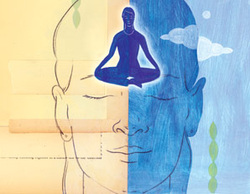 Since the transition into the new year, there have been many scientific revelations around the practice of mindfulness meditation. Mindfulness is focused attention, the observing of sensations and thoughts without getting caught up in them. Often the breath is the focus of mindfulness meditation, and yoga is an example of mindfulness practice. Meditators and yoga lovers have known the power of focused attention, stillness and breath awareness for a long time—thousands of years, even. Through many recent brain scans studies, science now acknowledges several physiological benefits of taking just five minutes every day to pay attention to the breath:
Convinced like a scientist yet? So, where to begin? All you need in your busy schedule is five minutes. Try to pick the same time each day so it becomes part of your daily routine. Think of it as necessary as brushing your teeth, except you are “brushing” away stress from your brain! Sit comfortably. Begin taking normal breaths. Make sure you are breathing from your diaphragm (“belly breathing”) rather than your lungs only (“chest breathing”). Rest your hand above the stomach and below the ribs, which is where your diaphragm is approximately located. As you breathe normally from your diaphragm, you will feel your belly rise as you inhale, and retract as you exhale. Continue for five minutes. If you find your mind wandering (which you will!) during this time, gently bring your attention back to your breathe. Notice any sensations in your body, but do not let your mind have a conversation about them. Simply bring your attention back to your breathe. Notice sounds around you, but again, don’t let your thoughts go on about them. Let your belly breathing be your primary focus. Keep a journal of the changes you notice over time. People have told me that their doctors asked them why their blood pressure was lower than their last check up. Others have noticed emotional equilibrium that wasn’t there before they began practicing. Others appreciate the sense of overall peace throughout their day. What benefits are coming to you through your practice? Further reading:
"'Mindfulness' Meditation Alters Gene Expression, Study Suggests", The Huffington Post | By Jacqueline Howard Posted: 12/09/2013 7:53 am EST | Updated: 01/19/2014 11:49 pm EST "The science behind meditation, and why it makes you feel better", GEORGE DVORSKY on IO9NEUROSCIENCE 4/04/13 11:28a "The Power of Concentration", By Maria Konnikova, Published: December 15, 2012 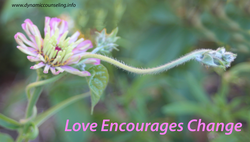 Each new year brings new energy and desire for change! Often when we have something we want to change in ourselves, the first response we have is anger, frustration, rejection. We then try to go about our desired change with a hammer over our heads! How many of us do well while getting bossed around, criticized and rejected? It might work for a little while—or a long while, if we are super-tolerant—but after a time, we stop trying so hard, or try to get away from the hammer, thus avoiding the task at hand. We do better at change when we have encouragement, acceptance and a caring eye guiding us in the new behavior. Who is the best person to do that for you? Maybe you have a supportive friend, or an encouraging therapist. But you are with you all the time! You are the one who will walk with you through all of the ups and downs of life! Here are a few ways to encourage yourself through any change you want to make:
A little love goes a long way to melt raw materials and create a masterpiece. Take a best friend with you into 2014…YOU! Happy New Year, and happy new YOU! 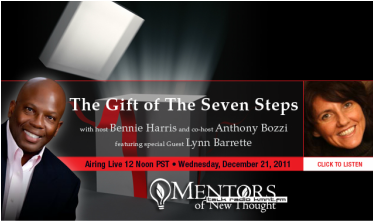 Two years ago, I had the privilege of participating in a three part web radio series on Jane Elizabeth Hart's powerful processing tool, Seven Steps for Successful Life Transitions, with Jane Elizabeth and my awesome husband, Gregory Barrette. Since it is a time of transitioning from one year into the next, I wanted to re-post these audios on the Seven Steps. Releasing the old year is an essential part of making room for a new year of experiences and spiritual growth! The first interview in the series, called "How to Move into the New Year Empowered", was with author and spiritual teacher Jane Elizabeth. Click here to listen. For more information on her formula for moving through changes, Seven Steps for Successful Life Transitions, and empowering yourself for the new year, click here. While you are there, check out the free spiritual resources available at Center For Enlightenment. "Every problem in life is here to support your soul's evolution. Unless you have a challenge, you will never know your capabilities. Your problems are not awful. They are the most wonderful tools designed to push you forward!" ~Jane Elizabeth My interview was next: "The Gift of the Seven Steps." Listen to the recorded show here: Mentors of New Thought Radio. Below is the description of the program: "My work with clients is to help pull out the patterns and help make the unconscious conscious," says therapist and spiritual counselor Lynn Barrette, LCSW. "Or, as leading psychiatrist Dr. Dan Siegel says in his book, Mindsight, “In order for us to become aware of the feelings inside us—to consciously attend to and understand them—we need to link these subcortically created emotional states to our [higher thinking] cortex.” Or, in spiritual terms, making the unconscious conscious! In order for us to heal the buried emotions and the beliefs that are sustaining them, we need to become aware of our hidden patterns that keep us stuck. "Jane Elizabeth's Seven Steps for Successful Life Transitions is the greatest, most thorough processing tool I have found to uncover and heal unconscious patterns, for myself as well as my clients." The final show in the series was with Gregory Barrette. Greg spoke about leaving the old year behind and "Making a New Start" in the new year. Here's what he says about this powerful tool: "The Seven Steps method is the single most effective way I know to forgive and release old, past issues and experiences... to fully let go of all that has happened in the past year and open up to a new experience in 201." Listen to to Greg's interview here. However you use the Seven Steps process, it will help catapult you into new spiritual understanding in many different situations in life. Try it out, and let me know how it works for you!  “I’m too spiritual for a diagnosis. I’m not going to take medication, and besides, what does a diagnosis have to do with spirituality? ” I have been asked this question frequently, and understandably so. There is still a lot of stigma on mental health issues, not only because of insurance issues, privacy or the fear of being judged as “crazy”; but also among the more spiritually-minded folks who don’t want to identify with the label. Some people feel that having a diagnosis will somehow become a mental block for wholeness. Ironically, every once in a while, I will hear “I am a [such-and-such number] on the Enneagram”, or “I am a [four letters] on the Myers-Briggs scale” as a reason why they are unable to change who they are or how they manage their lives. But just as these personality-type labels can serve as a self-awareness tool–not a lifetime sentence–a diagnosis can bring light to areas to push a little harder, or surrender a little more, in order to support the evolution of soul awareness. Spirituality is not the absence of issues—including diagnoses—but the working through them. Instead of seeing a diagnosis by your doctor or therapist as a lifetime sentence, try using it as a tool for understanding those limitations you are here to overcome. Any diagnosis can show us our strengths and limitations. Our job is to use those measurements to understand ourselves, and move forward where we have been limited, using the strengths that we have accumulated! For example, if you have anxiety, what tools can you use to support your own peace of mind? If depression is a problem, how can you stretch beyond your comfort zone? Attention deficit issues? What a great opportunity to learn focus and presence! Your solution will be as unique to you as the challenges that you are dealing with. Get support. You don’t have to do anything alone! And by all means, if medication will support you best, go for it! It is sad to me when a client won’t allow themselves to benefit from medication, and continues to struggle with a brain make-up that is overwhelming them, in spite of their best efforts! Years ago, I had to get off my judgments and fears regarding Western medicine. It was the Universe telling me, “Let go of your hang-ups, lady! You have to learn to trust Me in whatever way I direct you!” Be open to your soul’s messages. This will benefit your spiritual development the most. Take the outer signs within you, and ask your inner guidance “How can this benefit my soul growth?” Don’t be too spiritual for a diagnosis. Be too spiritual to stay stuck. The power to imagine will ease you into something greater than where you are right now. Let your imagination awaken you to new possibilities!  Detachment is a difficult thing to do. I’m talking about spiritual detachment: Being “in the world, but not of the world”. That is different from being aloof or disengaged from people or situations in our lives. Picture a core of light, with strings moving out from that core, attaching themselves to all sorts of things: One string attached to our partner. Another attached to our children. Another attached to our job. Another to money. And others to friends, resentments, good things, difficult things, and on and on! And all these strings are using our core energy, the energy we came in with to support us through everything. We have to work very hard to keep these attachments going. They have become part of our personality’s identity, and can get in the way of our seeing clearly. How can we make a good decision about our job if we are afraid of letting it go, even if it is for something better? How can we help our loved ones wisely when we are attached to them, or to the outcome of their situation? Our awakening is about letting go of our attachments, and allowing those strings to connect to our inner soul force, soul energy. Not all at once. Not blindly. Slowly, wisely, and with conscious intention. Day by day, we release our limited ideas of what can be, to be aware of the grander scheme that we are usually not aware of. When we were getting ready to have a second child, I was looking into midwives to assist the delivery. Our first child was born at home, and I wanted a similar experience once more. I also had MANY faulty judgments about hospitals, doctors and childbirth--none of them positive or worthy of repeating here. My intuitive guidance, as I looked for midwives the second time, was, “You won’t have this child at home.” I felt afraid. Why not? My automatic assumption was that there might be something wrong with the birth, the child, or me. I tried to force the issue, but the guidance was too strong, and I backed off. I found a midwife, but one who worked with a doctor and delivered in a nearby hospital. I started before I was even pregnant releasing my attachment to a homebirth, which included releasing the fears about hospitals and doctors. Every time I would go in for a check-up, I would have another round of fears come up to be examined and released. For an entire year I worked on this detachment! By the time I went into the hospital to deliver, I was free of my fears and could embrace the experience! My spiritual teacher, Jane Elizabeth Hart, said to me, “Go into that hospital as if you were walking into God’s hands.” I did, and had no resistance to any of the medical personnel who helped me. Everything went smoothly because I got out of the way, released my fears and attachments to how the process was going to look, and trusted. I detached my soul energy from fears, and reattached that energy into my Divine Self that knew what it was doing. I released from fear and false judgments, and plugged into Soul force. There is no outer picture that is the “perfect” scenario. We have to be open to what is the highest good for our souls—and all souls involved—in the moment, and that might just be very different than our human picture of what “should” be! Knowing your highest good in the moment comes through detaching, slowly but surely, to lesser ideas each day, and plugging into your Soul that knows!  There is always a solution. One of my primary jobs as a therapist and spiritual counselor is to be that objective person who can see what I call the “third option”. What is the third option? The third option is that other possibility for moving through a tough situation. Perhaps there are several “third options”, but when we are feeling stuck, we tend to see our situation in rigid, black or white terms. For example, someone who feels stuck in his or her career may only be able to see two limiting options: “Stay here and suffer, but at least I’m getting paid,” or, “Quit my job and be unemployed because the economy is so bad.” This is a good time to look for those third options! Why is the third option so hard to see? In the above example, you may be able to quickly see that there are certainly other possibilities than those mentioned. But, when we are in the middle of our own stuck place, it can be hard to see third options! Our own circumstances trigger our emotions, which keep us from being able to see other possibilities. Can you guess which emotion is most prominent in our example above? You are correct if you guessed fear. Fear is one of the biggest blind spots we have as human beings. It keeps us from seeing beyond the two walls that feel like they are caving in on us! Fortunately, our fears are seldom accurate; so having an objective viewpoint can help us see other choices that are there, closer than we may perceive. A close second to fear in why we’re sometimes not able to see the third option is that often they are wrapped up in things we may not want to do—and those might just be the action steps that would support us the most! Let’s face it: Our problems are here to stretch us, and stretching pulls us beyond our current state of flexibility…and comfort. That means that 99.9% of the time, we will have to do something we’d rather not. The plus side is that it often feels great to do just that! How can we learn to open ourselves to the third option? When we find ourselves feeling stuck, the first thing we must do is to recognize the potential (and need!) for growth. This will help relieve the worry and fear, and allow us to take a step back from the situation and see the bigger picture. Next, brainstorm possible solutions. Remember how we learned to brainstorm in elementary school? Everything goes! Write down all those potential solutions, even and especially the silly ones! Have fun trying to think of ways to resolve the situation. Make sure that list includes those options that you think you would never do. You might just come up with something you would do after all! Try asking yourself these questions:
There is always a solution, and we can find it when we step back and look at the bigger picture!  No, I’m not talking about soccer. Or rugby. Or quidditch. I’m talking about those goals you made last month for the new year. How are they going for you? Committing to a goal is exciting. It brings with it new energy, new hope for happiness, and…change. Uh-oh. There it is. Change. Our commitments require us to change. If they didn’t, we wouldn’t need to commit to something in the first place, would we? We often secretly expect new year magic to come in and make us different so we can have the outcomes of our new year’s goals…which come from the awareness that we need to change. See? Tricky! Let’s look more closely at what our resolutions really require us to do. Run one of your goals through the following questions to see what you are really committing to: 1. What is my goal? (Keep it simple, realistic and attainable.) 2. What would keep me from achieving this goal? 3. What do I have to give up in order to make this goal happen? 4. What do I have to begin doing in order to make this goal happen? 5. What would support me in achieving this goal? 6. How can I break this goal down into manageable steps? 7. What is a good first step toward this goal? Knowing what we are in for when committing to anything helps us know how to be prepared and advocate for our success. You are an evolving soul that embraces change. Cooperate with that metamorphosis! |
Archives
April 2016
AuthorLynn Barrette, LCSW Blending psychology with spirituality, I offer tools for forgiveness, acceptance, meditation and relaxation, and positive parenting solutions. Categories
All
Archives
April 2016
|
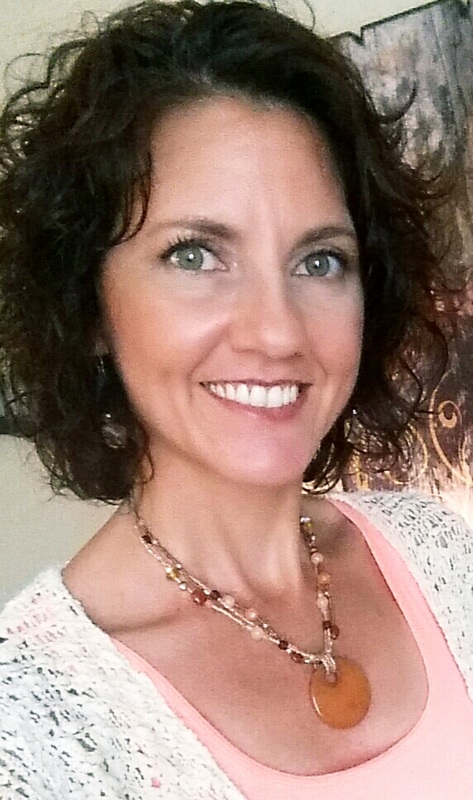

 RSS Feed
RSS Feed